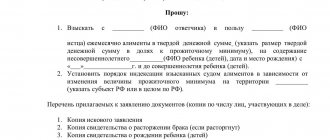6
Mandatory collection of alimony is carried out in cases where the child’s parents failed to reach an agreement voluntarily. But the initial collection of child support in court does not mean at all that the amount once collected cannot subsequently change towards a decrease or increase.
Alimony can be collected either as a share of all types of earnings of the payer, or be established as a fixed amount under certain circumstances. The law allows for further changes in the amount of alimony in relation to fixed payments, as well as, in exceptional cases, to maintenance established in shares.
When is a claim to change the amount of alimony filed?
There are many situations that can serve as a reason for dissatisfaction with the current amount of alimony payments, both on the part of the alimony recipient and on the part of the payer.
Current legislation provides for the possibility of increasing or decreasing alimony payments in court. This issue can be resolved in two ways:
- Voluntarily. The parties independently decide the issue of changing the amount of alimony payments, if they were initially fixed in the agreement.
- Forcibly. The amount of payments to be paid in the future is determined by the court.
The amount of alimony can be either increased or decreased by the court. In this case, everything depends on the financial solvency of the debtor himself.
Thus, a reduction in the amount of alimony paid is possible under the following circumstances:
- The payer’s income has dropped significantly and sharply, making it impossible to continue paying alimony in the current amount;
- New persons appeared in the alimony payer's support, such as children from a second marriage, disabled parents, etc.;
- The debtor has guardianship over a person with the first or second group of disability;
- The payer received a disability group or lost legal capacity;
- The debtor has adopted an additional dependent.
In addition, practice provides for enough cases when the recipient can also claim a change in the amount of alimony paid, for example:
- Increasing the solvency of the person paying alimony payments;
- Deterioration in the health of the person receiving alimony or his guardian, which reduces the child’s security and level of well-being;
- The emergence of circumstances that caused additional expenses for the maintenance of the child (education, treatment, etc.)
There are no conditions that in 10% of cases will lead to a change in the amount of alimony. The court will try to objectively evaluate all the evidence presented in order to satisfy the stated requirements.
Example. Ivanov A. pays alimony in the amount of 10,000 rubles in a fixed amount. The child’s mother, his ex-wife Ivanova Z., filed a claim to increase the amount of alimony, indicating that she is currently not working and this has reduced the quality of provision for the child. The court rejected the claim because Ivanova did not provide any valid reasons for her lack of work, and the very fact of a decrease in the solvency of the other parent cannot lead to an automatic increase in the amount of alimony from the second parent.
How to change the procedure for assigning alimony under a notarial agreement?
If funds for the maintenance of the child were assigned by concluding a voluntary notarial agreement , then you can change the method of collecting alimony:
- Voluntarily and mutually (upon reaching a joint agreement between the parties), by visiting the notary office to make changes to the original agreement document in accordance with Part 2 of Art. 101 IC RF.
- Unilaterally (if the consent of the other party is not obtained) - by filing a claim in the magistrate’s court in accordance with Part 4 of Art. 101 IC RF.
Of course, it is better for the parties to find a compromise and change the terms of the notarial agreement voluntarily , without going to court. This procedure will take less time and cause less inconvenience to the participants in the process.
How to file a claim
In almost every case, the reason for resolving a controversial issue in court is the lack of mutual understanding and compromise between the parties, each of which pursues its own interests. Changing the amount of child support is allowed only through a lawsuit and is initiated by filing a corresponding application.
A claim for revision of the amount of alimony must be filed in accordance with Art. Art. 131-132 Code of Civil Procedure of the Russian Federation. Violation of these rules will result in the claim being abandoned or even returned. At the same time, nowhere in the law are special requirements specified specifically for claims to change the amount of alimony - the applicant will have to be guided by the general provisions of the Code of Civil Procedure of the Russian Federation and established practice.
Form and content
A statement of claim, the subject of which is a change in the amount of alimony payments, must be structured in the following order:
- Name of the court;
- Personal information about the parties to the case, such as full name, place of registration or residence, as well as contact information;
- The price of the claim, namely the calculated amount of money by which, in the plaintiff’s opinion, the amount of alimony payments should be increased or decreased;
- Determination of the subject of the statement of claim;
- A full statement of the circumstances that led to the need to adjust the amount of alimony payments. These circumstances should be described from the moment the debtor alimony obligations arise, ending with the data that served as the basis for believing that the current financial situation of the alimony payer is conducive to changes in the amount of alimony payments. The information provided must be supported by facts and relevant documents.
- Reflection of the current amount of alimony, as well as the procedure for receiving such payments by the plaintiff.
- The motivation part, which precisely sets out the claims, as well as the legal basis for such claims.
- List of additional materials attached to the document;
- Date of document preparation and signature of the applicant.
Sample claim to change the amount of alimony
To successfully consider a claim, it is better to entrust its preparation to experienced lawyers. If this is not possible, you can try to compose it yourself. An example of a claim for changing the amount of financial support using the example of reducing alimony is posted below.
IMPORTANT: Please consult with a lawyer before you begin drafting the document yourself. The help of an experienced specialist will help you avoid common mistakes and successfully submit documents to the court the first time without the risk of return.
Reduce child support payments for children from different marriages
The payer has another obligation regarding alimony payments and when adding up the amounts of alimony, they exceed the maximum established by the Legislation of the Russian Federation. For example, a mother is the payer to support her child from her first marriage.
The amount of payments is ½ part of income. If in her second marriage she had a child, and she again has to pay child support. It turns out that in total, these payments exceed 33%. Then you can apply for a reduction in alimony payments.
But in this case, you need to file 2 identical statements of claim that the reduction in alimony was equivalent in relation to each obligation.
Valery Isaev graduated from the Moscow State Law Institute. Over the years of work in the legal profession, he has conducted many successful civil and criminal cases in courts of various jurisdictions. Extensive experience in legal assistance to citizens in various fields.
Alimony is paid for the maintenance of minor or incapacitated parents and other family members. Funds are transferred both under a voluntarily concluded agreement and by a court decision, where the amount is clearly indicated.
But it is possible to reduce alimony if special circumstances arise. In what cases is this possible?
Jurisdiction
A claim to change the amount of alimony can be filed both at the place of residence and registration of the defendant and the plaintiff.
IMPORTANT: A claim to reduce the amount of alimony can be filed at the plaintiff’s place of residence only if a minor child lives with the plaintiff. In other cases, claims at the initiative of the alimony payer are filed only at the place of residence of the defendant - the collector.
Also, it is worth noting that the category of claims related to alimony payments is considered in most cases by the magistrate, but there is an exception - a statement of claim, the subject of which is disputes related to the interests of children. Such claims are subject to review by a district judge.
Persons with the right to appeal
To apply to the court for collection of arrears of alimony, citizens must be:
- biological or adoptive parents;
- family having custody of the child;
- representatives of the educational organization;
- honey. institution;
- guardianship authorities.
In other words, any persons or organizations that are involved in the upbringing and maintenance of disabled children under 18 years of age. An application for alimony or accumulated debt must be submitted to the judicial authorities at the place of residence of the applicant.
In cases where we are talking about a dispute in which payments should be reduced, the claim is also filed at the address of the claimant.
Expert opinion
Davydov Alexander Yurievich
Civil law consultant with 20 years of practice. Author of numerous articles on legal topics
As for the claim itself to reduce alimony payments, it must be correctly and correctly drawn up from a legal point of view. In addition to the details, it must contain the following information:
- judicial contact information;
- the essence of the request;
- reasons for filing the application;
- attached regulatory framework and facts;
- explanations in the disputed payments;
- data on the pre-trial method of dispute resolution (if any);
- list of documentation.
In addition to the real circumstances due to which it is necessary to reduce alimony payments, there are also reasons that are not grounds for a reduction.
So the next area of justification cannot be satisfied. Let's look at it in detail:
- you cannot refer to the fact that the recipient has increased his well-being;
- the emergence of movable and immovable property from the raising parent (provided it is not used as income);
- the child receives government support in the form of subsidies.
Also, when considering a dispute, the magistrate will calculate the new amount based on factors such as:
- what is the percentage of payments withheld:
- the number of relatives of an incapacitated nature;
- what level of percentage is deducted in favor of all children supported by the applicant.
In a situation where alimony was calculated in shares relative to the payer’s income, then their reduction will occur in the same way. The court has the right to satisfy the claim in full or in part, but only if the debts incurred and the grounds for reducing them are valid. These factors include:
- serious illness;
- financial situation;
- the presence of a disabled child in a second marriage, etc.
In order for the court to consider a dispute regarding the reduction of alimony and make an appropriate decision, it is necessary to draw up a statement of claim and send it to the magistrate at the address of the alimony recipient.
Submission order and stages
In order to implement this method, the interested party must go through the following steps:
- Preparation of a statement of claim . This document must reflect exactly all the circumstances that served as the reason for filing the claim, indicating the reasons why the plaintiff considers it fair to change the procedure for paying alimony, while referring to the facts.
- Payment of state duty . The state duty is calculated based on the size of the claim, namely the amount stated in the claim by which the amount of alimony paid should be reduced or increased.
- Filing a claim in court . This stage is the last in the algorithm for filing a claim. For this purpose, the applicant must submit a statement of claim with all additional documents to the territorial court office.
After completing this procedure, the parties to the case will have to wait for the court’s decision to accept the submitted document for production and notification of the start of the hearing on the case, or to return the claim without consideration.
The judge has 5 days to consider the claim to determine whether it complies with the law. After their expiration, the document must be accepted for production or returned.
Procedure
- Discuss the problem that has arisen, ways to solve it and reduce the amount of payment. It is very important to clarify the specific amount or percentage by which the payments made will be reduced, since this is the main “stumbling block”.
- Make changes to the agreement.
- Have the changes notarized.
- Follow the new rules.
If, after signing a new document, either party does not fulfill its obligations, the other party has the right to sue it in court.
Documentation
The plaintiff must attach the following documents to the statement of claim:
- Copies of identification documents of the debtor and the claimant;
- Copies of documents indicating the fact of marriage and divorce;
- If necessary, photocopies of the children's birth certificates are attached if alimony is paid to minors;
- A document that obliges the debtor to pay alimony payments - a copy of the document. leaf. Court decisions. court order;
- Documentary substantiation of the facts that the plaintiff refers to as substantiation of the claims.
- Receipt for payment of state duty;
- Copies of the claim for all parties to the case.
The vast majority of documents can be submitted in copies, but be sure to bring the originals with you to the court hearing. The court may request them for study or review during the hearing of the claim.
Reasons for recalculating alimony payments.
There are good reasons for reducing alimony, which will reduce the amount of benefits. Payment recalculation is possible in the following cases.
- Due to the worsening financial situation of the payer.
- If the alimony recipient has been assigned a disability.
- When a new child is born in another family.
- The payment recipient has an additional source of income that significantly exceeds the amount of payments.
If a child who has reached the age of 16 has his own income (from renting out housing, dividends from a bank account, etc.), which allows him to meet his needs, then this is the basis for reducing the amount of alimony.
To do this, you will need to file a corresponding application with the court. All circumstances will be considered at the meeting.
In cases where the payment of alimony greatly worsens the condition of the payer, but is insignificant for the recipient of the benefit, its amount may be reduced.
In the case where the father pays funds in the amount of 25% for the maintenance of one child, but a second one is born in another family, the amount may be reduced. The law stipulates that the payment for two children should not exceed 33%. T
Thus, it is divided into two parts, even if the babies are from different women in different families. Each of the children will receive only 16.5% of the payer’s official earnings.
Expert opinion
Davydov Alexander Yurievich
Civil law consultant with 20 years of practice. Author of numerous articles on legal topics
It is also possible to reduce the amount paid per child if the minor is partially dependent on the state, for example, studying in a boarding-type correctional educational organization.
In this case, payments for its maintenance are necessary only during vacations or weekends.
The basis for reducing alimony may be the appearance of other dependents by the payer.
Thus, if there are incapacitated parents to whom assistance is paid, the alimony provider may qualify for a reduction in the amount of child benefit.
Alimony cannot be reduced if the following circumstances exist:
- the child owns property that does not generate income;
- the second parent raising the child has a high level of income;
- receipt of pension payments by minors.
This is important to know: How to return goods to the supplier: required documents
State duty
The state duty on claims to increase or reduce the amount of alimony is calculated in different ways.
When filing a claim to increase the amount of alimony, the applicant is exempt from paying the fee, since this claim is equivalent to a standard alimony claim. An amount of 150 rubles will be recovered from the defendant if the claim is satisfied. At the same time, a number of courts require the calculation of an increase in the amount of alimony as a benefit, but this is the wrong approach - after all, alimony is collected not in favor of the recipient, but for the child.
But if the amount of alimony is reduced, the plaintiff will have to calculate the amount of potential benefit and calculate the fee according to the rules of Art. 333.19 of the Tax Code of the Russian Federation for claims of a property nature. For more details, see a separate publication on the amount of state duty when reducing the amount of alimony.
Thus, the potential property benefit will be determined by the formula:
Amount by which child support is reduced * 12 months = potential benefit.
If the plaintiff asks to reduce alimony from 10,000 to 5,000 rubles. Then the potential benefit will be 60,000 rubles. It is from this that you will need to calculate the amount of the duty according to the rules for property claims.
Birth of a second and subsequent child in a second marriage
If the reason for the appeal is the birth of a child in a second marriage, then this is not a basis for the court to reduce alimony for the first. Also, if no agreement has been concluded, then in accordance with Article No. 81 of the IC of Russia, monthly payments must be made for incompetent children, the amount of which is established by the judge, namely:
- for the first child, payments are ¼ of the income;
- for two children, at least ⅓ of the share must be transferred;
- and if three or more children are born, then half of the salary is transferred.
These payments may increase or decrease depending on the decision of the judge. To resolve the issue in your favor, you must provide specific reasons. Which? We have listed in the previous sections.
Judicial practice in cases of changing the amount of alimony
It is impossible to identify any single position of the courts on the issue of changing the amount of alimony. Each case is considered individually and each case has its own arguments and grounds.
The bulk of claims for changes in the amount of alimony concern cases of the birth of a child from a second marriage, which gives payers legal grounds to demand a reduction in alimony from ¼ per child. Collected initially, up to 1/6.
Several cases from different parts of the country can be cited as examples of other situations.
Case No. 2-544/2015 of the Krasnogvardeisky District Court of the Stavropol Territory.
The plaintiff filed an application to increase the amount of alimony due to the fact that the payer’s material well-being has improved significantly over the past couple of years. The payer previously paid 10,000 rubles in alimony for one child, but the plaintiff is currently demanding an increase in the payment to 20,000 rubles. The court rejected the claim, since the need for this amount was not justified, and information was not provided about the plaintiff’s fulfillment of her obligations to support the minor.
Case No. 2-577/2016 of the Belorechensky District Court of the Krasnodar Territory
The plaintiff filed a lawsuit to reduce the amount of alimony assigned in a fixed amount, indicating that he was obliged to pay 7,500 rubles monthly for one child. Due to the loss of his job, the onset of group 2 disability and deteriorating health, he is unable to pay this amount. He asks to reduce the payment amount to 5,000 rubles.
The court satisfied the request, recognizing the circumstances as valid and affecting the payer’s alimony obligations.
When can the alimony collection procedure be changed?
The law, by the way, does not regulate guaranteed circumstances that entail changes in the procedure for paying alimony.
All provisions of the Family Code regarding methods of collection are advisory in nature, and the final decision in any case remains with the judge.
But for each option for changing the collection procedure, general criteria can be derived by simply analyzing existing practice.
Changing the share recovery of alimony to a fixed amount
As mentioned above, the shared method of collecting alimony is used when the payer has clear and official income. But there are often cases when the official income initially available at the time of the trial by the payer is lost or greatly reduced.
Cases where a man pays minimum alimony from benefits can be ignored - this is not a basis for changing the collection procedure. In other cases, if a man pays small alimony for no reason, replacing it with a fixed amount may be a good solution.
The right to replace the share penalty with a fixed amount can be exercised by the payer in the following cases.
| No. | Cases when it is possible to change the collection procedure |
| 1 | The official income of the payer is minimal, but there is objective data on side income: rent from the rental of real estate, other property, business activities |
| 2 | The alimony payer has no confirmed income at all or is unofficial |
| 3 | It is impossible to determine the amount of income each month due to its seasonality or irregularity (for example, a builder receives a payment once every 3-5 months as work on the site is completed, while he has no income for the remaining months) |
| 4 | The child requires additional maintenance for treatment or rehabilitation |
The application will need to document the amount of alimony. You can’t just refer to a certain amount. Typically, maintenance in a fixed amount is tied to the subsistence level for the child and is assigned equal to it or in some fraction - 0.3, 0.5 of the subsistence level, and so on.
Any reason is suitable to justify the need for funds:
- treatment of the child;
- sports sections and clubs;
- additional education.
But be careful - the father may wonder whether the mother herself spends money on maintaining the child. If the ex-husband pays alimony regularly and, objectively, it is enough to support the child, he may demand a report on its expenditure
Changing the recovery from a lump sum to a shared one
As a rule, alimony in a fixed amount is collected when it is difficult to determine the amount of the payer’s income or its complete absence. Another common reason is that everyone, both the court and the plaintiff, understands that the defendant has unofficial income, but there is no way to prove it, so alimony is prescribed in an amount that is a multiple of the minimum subsistence level for the child.
When the payer acquires official income, and the maximum allowable percentage of alimony from his salary clearly exceeds the fixed amount, the claimant may demand a change in the collection method.
Unlike changing the collection method from a shared lien to a fixed amount, in this case everything is simpler.
A little evidence is required:
- information on alimony payments for the last 3 months;
- certificate of income of the defendant (petition to claim it).
The court, having analyzed the information and determined that the demands are justified and the child will receive a larger amount of maintenance, will satisfy the application.
Important! If the payer is a large individual entrepreneur whose income obviously exceeds the real needs of the child, the court may leave alimony in a fixed amount by simply increasing it. The insurance policy obliges the child to maintain the level of support within the same limits as when he was living with both parents.
Example. The child's mother filed a lawsuit to change the method of payment of alimony against S.'s ex-husband, indicating that his current income was several dozen times higher than that which occurred when the court's decision was initially made. According to information from the Federal Tax Service, the defendant’s declared monthly profit amounted to about 1 million rubles. The plaintiff demanded to change the method of collecting alimony from a fixed amount of 20 thousand rubles to ¼ of all types of earnings.
The court, taking into account the counter-demands of the defendant, who asked to increase alimony to 45 thousand rubles, with half of it transferred to the child’s account, sided with the defendant. The change in the method of collecting alimony was refused, alimony was increased with the obligation to transfer it to the child’s account in an amount of at least 50%.
Court decisions (examples)
The practice of reducing alimony clearly demonstrates situations that confirm the thesis that both the legislator and representatives of Themis by default stand on the side of children and single mothers. Most often, fathers who want to reduce the amount of payments have to carefully collect evidence to support the justification of the claim.
For example, in the claim of citizen V.A. The following are stated as grounds for satisfying his demands:
- His minor son receives additional income.
- The source of money is the online store.
The court refuses to satisfy the claim, arguing as follows:
- The child's income is unstable and irregular.
- The amounts obtained through such employment cannot provide for the child financially.
- The funds received were spent by the minor on the treatment of his mother.
- The total income of the child's father increased, but this did not affect the amount of financial support for the child; apart from the transfer of alimony, the payer did not participate in any way in the life of the heir.
Another case in which citizen A.A. appealed to the court with a demand to reduce the amount of alimony for the following reasons:
- He started a second family and had another child.
- The salary level remained the same – 80 tr.
- Employment has not changed, the plaintiff is employed at two enterprises, the possibility of additional earnings is excluded due to lack of time.
- Half of the income is spent on paying the mortgage.
- A quarter of the income goes towards child support.
- The wife does not receive income, cares for and raises the child.
- After all mandatory payments, the same amount remains for three family members as is transferred for only one child.
The court granted this appeal in full. The amount of alimony was reduced to 13.5 thousand rubles.
Another illustrative case. Before going to court, the plaintiff received an order from another representative of Themis, who assigned alimony for the second child in the amount of a quarter of his income. In the claim, the payer indicated the following:
- The decision of the first court appointed alimony for the first child in the amount of 25%.
- An order from another institution established monthly payments for the second child in the same amount.
- The total deductions for the financial support of two children are 50% instead of 33% specified in the law.
In this case, the court satisfied the requirements and reduced the amount of alimony for the first child by a third to 16.5%.
Obtaining an order before filing a claim, as in the case discussed above, is more a necessity than a precaution. There are many court decisions refusing to satisfy the payer’s demands, which state the following:
- There is no evidence that confirms that the applicant financially provides for other children.
- The fact of living together with the mother of another baby (or babies) does not apply to such evidence.
As a rule, such court decisions are made if the plaintiff relies on his own strength and neglects the help of a family lawyer, at least in the form of a consultation. Just one contact with a legal practitioner allows you to avoid most mistakes and dramatically increases your chances of winning your case in court.
How payments through the court change
If there is a need to change payments through the court, then you should first contact the magistrates' court. The cost of the claim cannot exceed 50,000 rubles. In other cases, documents are submitted to the district. Step by step the whole procedure could be like this:
- First of all, a citizen must collect all the necessary evidence that will confirm that there really are grounds for increasing or decreasing payments.
- A statement of claim is drawn up and submitted with other documents to the court.
- the parties must receive notification of the date of the meeting, which can be set in the form of a letter or SMS.
- A meeting is being held. It happens that one hearing is not enough, then a second one is appointed. The review period is 2 months.
- A court decision is made, and then a writ of execution is issued. It will be provided to the FSSP or at the place of work of the alimony worker.
Changes in payments to a grandparent
It happens that older people do not have children who are able to support them, in which case grandparents can file a lawsuit demanding that their grandchildren support them. In this case, the following reasons must exist:
- Establish that older people are truly disabled.
- There is no way to collect alimony from relatives who come first.
It is important that the grandchildren are employed and of age. An agreement may also be concluded between the parties. If it is not there, then the whole process will be carried out in court. Such payments may be assigned in a fixed amount. If it turns out that the grandchildren cannot support their grandparents because they themselves have children or are considered disabled, then you can send a petition to change the amount of alimony or cancel it.
Reduced child support in 2021.
There are two ways to reduce the amount of alimony:
- changing the terms of the alimony agreement;
- through a court decision.
If the former spouses initially reach an agreement, then they enter into an alimony agreement, which specifies the amount of payments, form, terms and other information.
If special circumstances arise, both parties may agree to reduce the benefit amount.
If the other parent is not against the changes, they are included in the agreement. In this case, the document and all amendments must be certified by a notary office, otherwise they will not have legal force.
In the case where payments were initially established by a court decision, their reduction must also be achieved through government agencies.
To change the amount of alimony, you must submit a corresponding application to the court and wait for a decision.
The documents can be submitted directly by the payer or his representative who has a power of attorney for these actions.
The decision will not affect the form of payment of alimony; it will remain the same as in the original decision on the assignment of benefits.
Download the application for alimony reduction here:
Appeals to higher authorities
If the magistrate refuses to satisfy the claims, you can resign yourself or file a complaint for appeal and cassation. An application to these authorities is submitted by analogy with a claim. The document must indicate :
- The name and address of the institution to which the appeal or cassation is filed.
- Last name, first name and patronymic of the defendant and applicant.
- When and by what institution the decision was made.
- Brief summary of the matter.
- What are the violations of substantive and procedural law committed when making a decision?
- Links to legal norms and evidence.
- Appellant's claims.
- List of attached documents.
- Date of compilation and signature.
The period for filing an appeal is 1 month , for cassation - 5 months or one month more if an appeal has not been filed. As a rule, people turn to higher authorities in connection with disagreement with the decision made on the merits. Complaints about unfounded refusals to accept a claim or return it are isolated cases.
Legal basis
The main document that controls issues related to alimony is the Family Code. For example, in Art. 101 there is a certain procedure for changing the settlement agreement that the parties can draw up among themselves. Amendments can be made, but only if the parties agree to this. If a controversial issue arises, the decision may be transferred to court. Taking into account Art. 119 of the Family Code, if there is no agreement, then changing the amount of alimony established by the court is also considered in court. In addition, there is Resolution of the Plenum of the Supreme Court of the Russian Federation dated December 26, 2017 N 56 “On the application of legislation by courts when considering cases related to the collection of alimony.”







